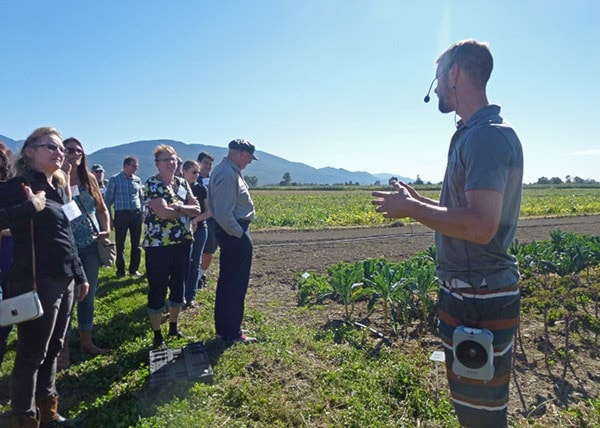A pair of coach buses packed with Ag Tour participants crisscrossed Chilliwack all day Friday.
The five host sites on the annual 2014 Chilliwack Agriculture Tour were in the spotlight for different yet compelling reasons.
A quest for sustainable practices, innovative approaches and staying ahead of the curve, were elements they all had in common.
First stop was Rainbow Greenhouses on South Sumas Road, in the throes of benefiting from a recent expansion. They are also industry leaders in recycled agricultural plastics, and have applied the greenest techniques possible.
Then it was on to Esau Industries hazelnut orchard on Prairie Central, owned by Walter and Lenora Esau, home to some critical test growing of blight resistant varieties of hazelnut trees.
The Agriculture Centre of Excellence at UFV on Cain Avenue was bustling. The state-of-the-art greenhouse and livestock barn infrastructure is falling into place for agricultural research at the highest levels.
Smits and Co.w Farm Cheese, owned by Ron Smits has gone from producing different varieties of handmade gouda cheese, to their newest line of goat milk cheeses.
Mayor Sharon Gaetz reminded the crowd that agriculture was a big part of Chilliwack’s past and its future.
“You might not know that the city just west of us has the top farm gate, but we’re second,” Gaetz said. “It makes our city so very proud.”
Chilliwack boasts close to 900 farms, and one in five jobs directly connected to farming.
The foodie trend is growing and drawing attention to Chilliwack, with 700 people participating in the last Slow Food Cycle Tour.
“We lift a fork to all of the farmers who work so hard,” she said.
Coun. Jason Lum spoke after lunch, thanking the farmers, organizers and sponsors, and mapped out two city initiatives, including The Agricultural Area Plan, and the Agricultural Advisory Committee.
“We have a long history of excellence. What we needed was to build on it.”
He touched on points about striving for excellence, and building on that which is already established. Creating knowledge, understanding and sustainability were also key, adding it was great to see the UFV Centre of Excellence evolve and grow.
Finally the tour buses arrived at The Local Harvest Farm Market, to hear Dan Oostenbrink’s plan to make Chilliwack “a more food secure city,” one crop at a time, all year-round.
Originally his vision was to develop the site into an agri-tourism destination on Lickman Road.
But eventually, that vision shifted to see them concentrate on growing a variety of food crops in the most natural, unadulterated way possible without the use of sprays.
He hired a 25-year-old grower, who eschewed sprays and embraced hoeing for weeds.
“That was when my initial transformation started to happen,” he told the crowd.
They would go forth using simple methods, ones that his late grandfather, a food farmer, would have approved of.
Oostenbrink was “blown away” by how much could be produced on a one-acre chunk of land, as they tested the limits.
He said they’ve undergone a “revolution,” albeit in a small way.
“We realized then we would head in a completely different direction. We were going to become, first and foremost, farmers and food producers.”
He now believes it is possible to feed 50 people per acre per year, and have people subsisting entirely on that one acre. Producing fresh food, within Chilliwack, and recognizing their most precious resource is youth, that is, in part, what he means by food security.
But is it financially viable?
“We’re starting to break even on the vegetables we grow, and we haven’t figured out how to grow yet.”
So the answer is yes, he does believe it will be possible to make a living selling bunches of carrots — and a host of other produce.
“It’s a lot of work. I’m not saying it’s easy. But it’s fun and you can make money doing it.”
